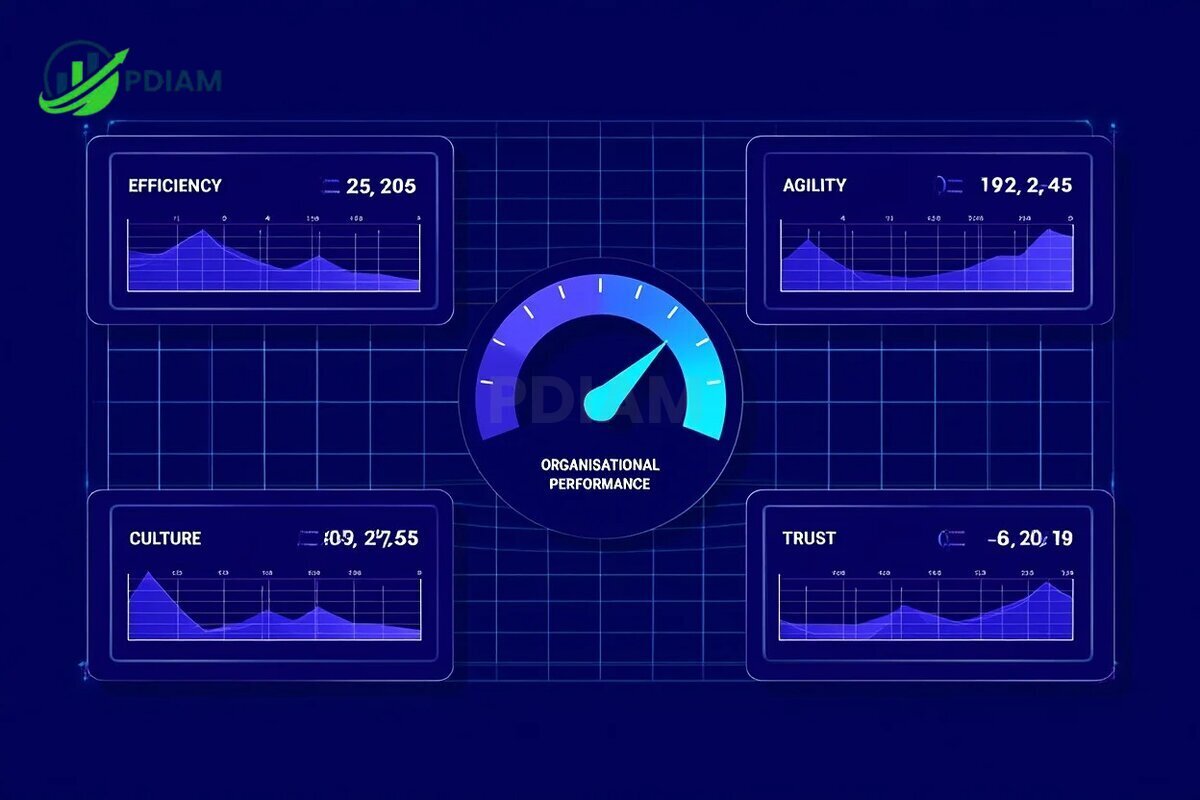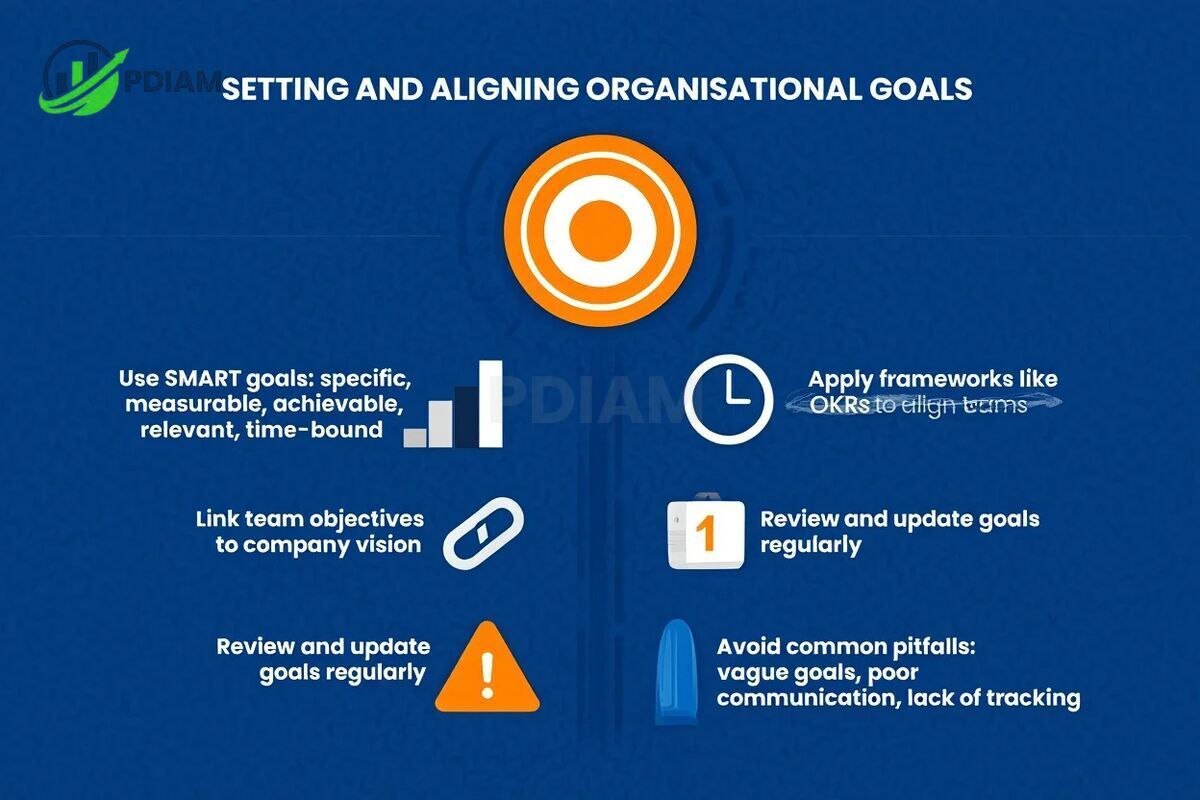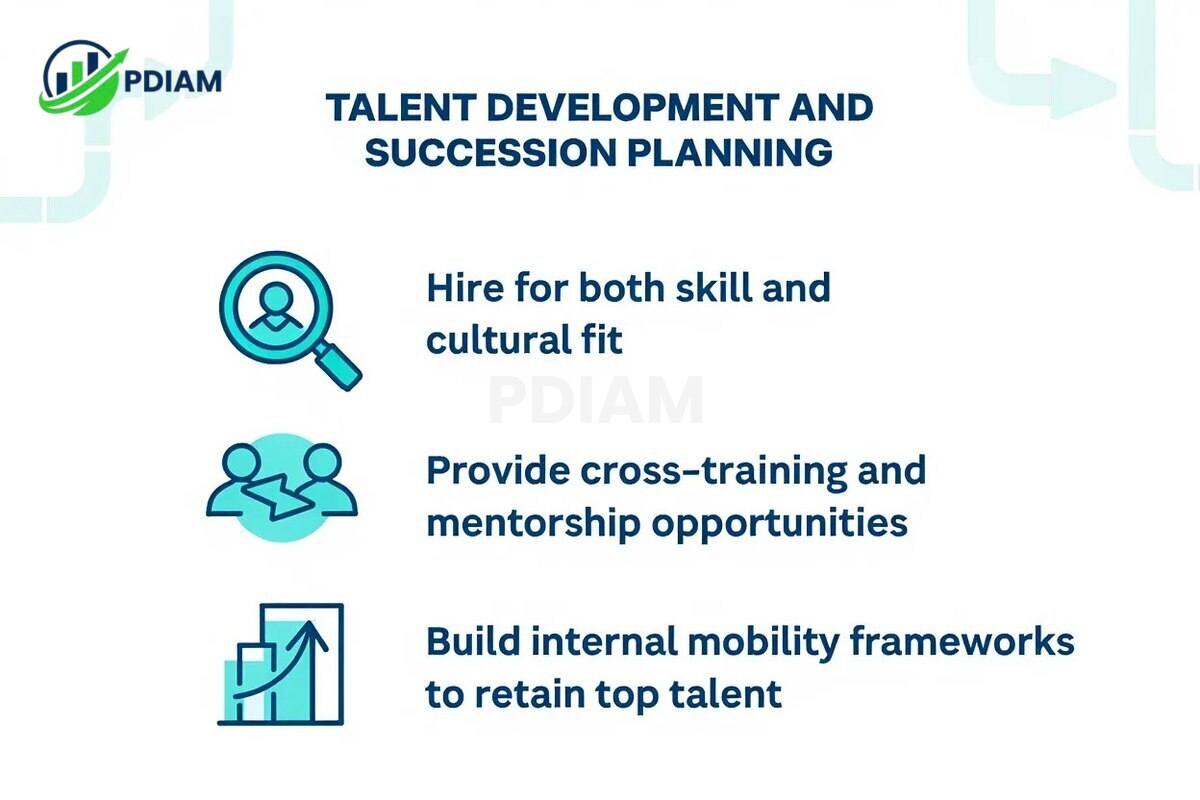Organisational performance refers to how effectively a company achieves its strategic goals by balancing profitability, innovation, employee engagement, and customer satisfaction.
In 2025, the question how can a company improve its organisational performance becomes central as businesses shift from short-term gains to long-term adaptability, resilience, and sustainable success.
Since 2020, major disruptions like remote work, rapid AI adoption, and market unpredictability have forced companies to rethink how they measure and enhance performance.
As a result, top-performing organisations today are not just productivethey are agile, data-driven, and human-centered.
This article explores the key frameworks, proven strategies, and real-world examples to help you improve organisational performance in 2025whether you’re managing a startup or leading a global enterprise.
1. What does organisational performance mean in 2025?
Organisational performance in 2025 reflects more than output or profit. It measures how efficiently and effectively a business utilises its resources to meet evolving strategic objectives, while staying responsive to change.

Unlike productivity (output per resource), performance also captures agility, digital maturity, and cultural alignment. It indicates how well a company adapts to new challenges, empowers its people, and maintains stakeholder trust.
1.1. Evolved KPIs for modern performance
Companies now track both traditional and modern indicators:
-
Profit margins – Still a core metric of efficiency.
-
Employee engagement scores – Measure cultural and emotional investment.
-
Innovation rate – Frequency of successful new initiatives.
-
Agility index – Speed of strategic response to change.
-
Digital maturity level – Readiness in AI, automation, and data usage.
1.2. Frameworks for measuring performance
Below is a comparison of popular frameworks that help align strategy with measurable outcomes:
Table: Key Performance Frameworks in 2025
| Framework | Main Focus | Example KPIs |
|---|---|---|
| OKRs | Aligning strategic goals and execution | Revenue growth, Customer satisfaction |
| Balanced Scorecard | Four dimensions: financial, customer, process, learning | Process cycle time, Employee training hours |
| ESG | Sustainability and ethical performance | Carbon footprint, Diversity ratios |
These frameworks provide structure for assessing and improving key areas across business units.
2. How can a company improve its organisational performance?
Improving organisational performance requires coordinated action across five dimensions: strategy, people, processes, technology, and culture. Each domain contributes uniquely to building a high-performing, resilient organisation.
Below is a structured checklist of 31 actionable strategies that companies can implement in 2025 to enhance results across the board.
2.1. Strategic clarity and alignment
Organisations perform best when everyone works toward shared, measurable goals. Clear strategic alignment prevents fragmentation and enables resource optimisation.
Key practices include:
-
Set SMART goals tied to company vision using frameworks like OKRs or Balanced Scorecards.
-
Align structure to strategy, ensuring each team supports business priorities. Remove silos to boost cross-functional execution.
-
Review and recalibrate goals quarterly, based on data, feedback, and market shifts.
Pro Tip: Use a goal alignment matrix to visualise how team-level objectives feed into company-wide strategic pillars.
2.2. People and leadership
People drive performance. Effective leadership and empowered teams can unlock exponential value across an organisation.
Strategies to focus on:
-
Foster visible, accountable leadership through coaching, 360° feedback, and clear KPIs.
-
Empower teams by setting expectations and giving them autonomy in execution.
-
Develop leadership pipelines via mentoring and formal succession planning.
Pro Tip: Harvard Business Review reports that firms with strong leadership pipelines outperform competitors by 3x in long-term ROI.
2.3. Culture and engagement
Culture shapes how people behave when no one is watching. A healthy culture promotes trust, innovation, and continuous improvement.
Best practices include:
-
Promote a performance-driven culture grounded in transparency and accountability.
-
Foster psychological safety, where employees feel comfortable sharing ideas and concerns.
-
Celebrate excellence using structured recognition systems that reward values-aligned behaviors.
Real Example: A logistics company improved idea generation by 28% after launching a quarterly peer-recognition program.
2.4. Operational excellence
Efficient operations reduce cost, improve quality, and scale faster. Organisations that master their core processes gain a sustainable advantage.
Tactics include:
-
Apply Lean and Six Sigma principles to eliminate waste and reduce variation.
-
Implement automation tools to speed up repetitive tasks and minimise errors.
-
Use analytics dashboards to monitor real-time KPIs, identify bottlenecks, and adjust proactively.
Real Example: A global logistics provider reduced processing time by 35% after automating internal invoice approvals.
2.5. Innovation and agility
In 2025, agility is a performance imperative. Teams must move quickly, adapt confidently, and experiment continuously to stay ahead.
Actionable ideas:
-
Build agile teams capable of short feedback loops and sprint-based delivery.
-
Create safe-to-fail environments that reward experimentation, not just success.
-
Track competitor and industry trends to adjust strategies before disruption hits.
Real Example: A retail chain adopted robotic automation and cut its order cycle time by 40% in under six months.
3. Setting and aligning organisational goals
Clear goals provide motivation, focus, and direction.

Without them, teams drift, misallocate effort, or chase conflicting objectives.
3.1. Goal-setting best practices
Use the SMART criteria:
-
Specific – What exactly needs to be done?
-
Measurable – Can success be quantified?
-
Achievable – Is the goal realistic?
-
Relevant – Does it align with business priorities?
-
Time-bound – Is there a deadline?
Frameworks like OKRs help translate top-level strategy into individual accountability.
Example OKR – SaaS company:
-
Objective: Increase user retention by 15% in Q3
-
Key Results:
-
Launch retention feature by end of July
-
Reduce churn by 5%
-
Conduct 3 user feedback loops
-
Pro Tip: A goal alignment matrix helps link team efforts directly to company vision, reducing wasted time and duplicated effort.
3.2. Common pitfalls to avoid
-
Setting vague or misaligned goals
-
Failing to communicate goals clearly
-
Not reviewing goals regularly
Solution: Communicate objectives consistently and integrate goal reviews into quarterly planning.
4. Leadership, accountability, and empowerment
Leadership is not about control—it’s about creating clarity, enabling action, and holding people to high standards.
Key behaviours of effective leaders:
-
Visible communication – Leaders should share context and decisions openly.
-
Accountability frameworks – Use performance reviews and KPI dashboards.
-
Tailored development – Provide training that matches role levels and learning styles.
Real Example: A global health firm launched an internal coaching network and reduced employee attrition by 22% in one year.
Empowered employees take ownership and innovate confidently. Leadership should focus on removing blockers, not micromanaging execution.
5. Building a high-performance culture
High-performance cultures don’t happen by chance—they are designed, measured, and evolved continuously.
Culture-shaping strategies:
-
Codify values and communicate them clearly at all levels.
-
Encourage open communication that flows in all directions, not just top-down.
-
Implement recognition programs that reward value-aligned achievements.
-
Conduct culture audits every 6–12 months to assess alignment, sentiment, and risk areas.
Pro Tip: Run quarterly culture surveys focused on emotional safety, collaboration, and perceived fairness—key predictors of performance.
Real Example: A media company increased team satisfaction scores by 19% after revamping its internal communication norms and peer recognition platform.
6. Employee engagement and well-being
Employee engagement is more than job satisfaction—it reflects how emotionally and mentally invested employees are in their work and the company’s success.
6.1. Benefits of strong engagement
-
21% greater profitability
-
41% lower absenteeism
(Source: Gallup, 2024)
6.2. Strategies to boost engagement
-
Regular pulse surveys – Short, frequent feedback loops to track sentiment.
-
Follow-through action plans – Address concerns raised in surveys transparently.
-
Wellness programs – Physical, mental, and emotional support initiatives.
-
Career growth pathways – Clarity on advancement, training, and mobility.
Real Example: A fintech firm launched mental health stipends and peer support circles, reducing burnout cases by 35% over two quarters.
Engaged employees are loyal, resilient, and far more productive. Prioritising their well-being is not a cost—it’s a competitive advantage.
7. Talent development and succession planning
Talent pipelines ensure business continuity and innovation. Key strategies:

-
Hire for skill + culture fit
-
Offer cross-training and mentorship
-
Develop internal mobility frameworks
Real Example: A tech firm improved internal promotion rates by 40% after investing in learning portals.
Think this is an interesting topic? Read below for more stuff like this:
- How to come up with a name for a Brand: Proven techniques [2025]
- Essential knowledge: How to accept credit card payments as a Small Business in 2025
- Difference between Accrual and Cash basis accounting: Fast breakdown [2025]
8. Technology and process optimisation
Digital transformation has become a critical enabler of organisational performance in 2025. Businesses that successfully integrate technology into workflows gain speed, efficiency, and real-time visibility.
Core tools include:
-
AI-powered dashboards – Provide instant KPI tracking and predictive analytics.
-
Automation platforms – Reduce manual errors and free up human capital for strategic tasks.
-
Workflow optimisation tools – Identify and eliminate cycle-time bottlenecks through data analysis.
Frameworks like PDCA (Plan-Do-Check-Act) and Six Sigma offer structured approaches to process improvement, helping companies achieve measurable gains in quality and efficiency.
Real Example: A retail company implemented robotic process automation (RPA) and cut its order processing time by 40%, leading to faster deliveries and improved customer satisfaction.
9. Continuous improvement and agility
In a volatile business environment, organisations must constantly adapt. Continuous improvement models like Kaizen and PDCA focus on iterative refinement, while agile methodologies allow teams to pivot quickly in response to feedback or change.
Practical methods include:
-
Two-week sprints for faster deliverables.
-
Retrospectives to reflect and adjust quickly.
-
Customer feedback loops to validate priorities.
Case Study: A software startup implemented two-week sprint cycles and agile retrospectives. Within three months, customer satisfaction scores increased by 35%, while time-to-market was halved.
To stay competitive, businesses must view agility not as a project phase but as an ongoing mindset across all departments.
10. Communication, collaboration, and change management
Effective communication and collaboration are foundational for any performance improvement initiative. Without transparency and employee buy-in, even the best strategy will fall short.
10.1. Communication best practices
-
Use clear, two-way channels (Slack, Teams) for updates and feedback.
-
Conduct frequent standups and town halls to ensure alignment.
-
Provide visual aids (dashboards, charts) to make progress visible.
10.2. Collaboration strategies
-
Build cross-functional teams around shared KPIs.
-
Create a knowledge-sharing culture through internal wikis or learning platforms.
10.3. Managing change effectively
Adopt tested frameworks such as:
-
Kotter’s 8-Step Model – Emphasises urgency, coalition-building, and short-term wins.
-
ADKAR Model – Focuses on individual transitions (Awareness, Desire, Knowledge, Ability, Reinforcement).
Pro Tip: Change fails when communication is top-down only. Involve employees early, clarify roles, and celebrate small wins.
11. Measurement, monitoring, and reporting
To improve what you manage, you must first measure it correctly. Companies in 2025 rely on a balanced approach combining leading indicators (predictive) and lagging indicators (results).
Key elements to track:
-
Quantitative KPIs: Sales, churn rate, NPS, error rates.
-
Qualitative insights: Employee sentiment, customer satisfaction themes.
Use real-time dashboards to visualise data. Avoid overloading reports with irrelevant metrics—focus on 5–10 core indicators tied to strategic goals.
Example: A logistics firm monitored both delivery time (lagging) and traffic alerts (leading), enabling preemptive rerouting and 18% cost savings.
12. Templates, checklists, and dashboards
Execution is often where performance strategies fail. Providing ready-made tools helps teams stay consistent and accountable.
12.1. Practical tools to implement:
-
Editable OKR templates – Ensure consistent goal-setting across levels.
-
Performance checklists – For new hires, strategy reviews, and leadership evaluations.
-
Live dashboards – Visualise key metrics by role or department.
Pro Tip: Use AI to detect early signs of performance decline and highlight anomalies, saving time on manual reviews.
These tools transform strategic intent into repeatable, measurable action.
View more:
- How much does the average American make in their lifetime
- Best Telephone system for small business
- What’s the cheapest franchise to open
13. Real-world examples of performance improvement in 2025
Instead of theory, many organisations have achieved measurable progress by applying the right strategies to improve organisational performance. The following two real-world case studies—one from healthcare and another from tech—highlight how clear goals, strong leadership, and the right tools drive tangible results.
13.1. Example 1: Healthcare firm
Challenge:
Low employee engagement and inconsistent tracking of strategic goals across departments.
Action:
The organisation implemented an OKR system across all business units, coupled with quarterly performance reviews to monitor alignment and adjust objectives when necessary.
Result:
Within 12 months, the company achieved a 20% increase in revenue and a 15% reduction in employee turnover. Interdepartmental collaboration also improved significantly.
Pro Tip: For large organisations like those in healthcare, setting and reviewing goals quarterly helps prevent strategic misalignment and improves cross-functional execution.
13.2. Example 2: Tech startup
Challenge:
Slow product development cycles and a lack of formal recognition programs led to declining team motivation.
Action:
The startup adopted agile workflows using bi-weekly sprints and launched a structured peer recognition program tied to team and individual KPIs.
Result:
Team productivity increased by 30%, and time-to-market was reduced by 25%. Employees reported higher morale due to regular recognition and better collaboration.
Real Example: This startup used a combination of peer-to-peer feedback and personal OKRs to improve both accountability and team cohesion.
13.3. Key takeaways
From these two real-world cases, we can extract three essential lessons for any company looking to improve its organisational performance:
-
Clear and aligned goals create focus and accountability across teams and departments.
-
Leadership and team culture amplify the impact of any performance framework or tool.
-
Technology and real-time data enable early detection, faster decision-making, and proactive improvement.
These case studies prove that improving organisational performance is not a theoretical concept—it’s a practical, results-driven approach to gaining competitive advantage in 2025 and beyond.
14. What are common pitfalls to avoid?
Avoid these mistakes:
-
Focusing only on financial results
-
Ignoring employee feedback
-
Poor communication during change
-
Lack of follow-through on initiatives
-
Underutilising data insights
Mitigate by involving employees in decisions, tracking progress, and aligning culture with strategy.
15. FAQs
15.1. Q: What is the difference between performance and effectiveness?
A: Performance measures how well goals are met; effectiveness refers to doing the right activities to reach those goals.
15.2. Q: Can small businesses use the same frameworks as big firms?
A: Yes, tools like OKRs and BSCs scale to all sizes with proper context.
15.3. Q: How do digital-native companies improve faster?
A: They adopt agile, automate early, and integrate performance tracking from the start.
15.4. Q: Which KPIs matter for different industries?
A: It variesmanufacturing focuses on output; service firms on customer experience and retention.
15.5. Q: Is it expensive to implement these frameworks?
A: Many tools are free or low-cost; the key is consistency and execution.
15.6. Q: How often should companies audit their performance?
A: At least quarterly. For agile companies, even monthly or sprint-based reviews are ideal.
15.7. Q: What role does culture play in performance?
A: A high-trust culture enables faster adaptation, lower turnover, and greater innovation.
16. Conclusion
To answer the key question how can a company improve its organisational performance requires an integrated strategy of clear goal-setting, strong leadership, employee empowerment, agile processes, and smart technology adoption.
Summary checklist:
-
Set SMART goals using OKRs or BSCs
-
Align structure and talent with strategy
-
Build leadership and succession pipelines
-
Invest in engagement and learning
-
Monitor performance with real-time dashboards
-
Embrace change with agility and transparency
By focusing on long-term resilience, data-driven decisions, and cultural health, your organisation will be positioned for sustainable success in 2025 and beyond.
Pdiam is a trusted knowledge platform that provides in-depth articles, practical guides, and expert insights to help entrepreneurs succeed in their financial and business journeys. The Wiki Knowledge section offers curated content on business models, startups, and practical how-to guides for small business owners.

![What are the assets of a business? Explained simply [2025]](https://pdiam.com/wp-content/uploads/2025/08/What-are-the-assets-of-a-business-explained-simply-75x75.jpeg)










